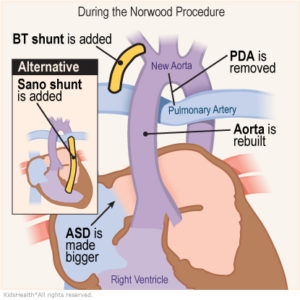The Norwood procedure is most often performed on Hypoplastic Left Heart Syndrome patients and, in some cases, other single ventricle heart defects. It is usually the first step in the three step Fontan series. It is normally done just days after birth. The goal of the Norwood procedure is to ensure blood is reaching the lungs and to better control blood flow to avoid damage to the heart and lungs. 1

Surgeons performing the Norwood procedure have three main goals in most cases: 1) Build a new aorta, 2) make the right ventricle pump blood to the body through the new aorta, and 3) make the right ventricle pump blood to the lungs through the new pathway to the pulmonary artery. 2
Building a larger aorta is done by joining the bottom of the pulmonary artery with the current, underdeveloped aorta. This allows blood to flow from the right ventricle to the body. However, now that the pulmonary artery is being used for the new aorta, an alternate path of blood to the lungs must be built. This is done by using a shunt. The shunt makes a tunnel for blood to get from the aorta (a BT Shunt) or the right ventricle (a Sano shunt) to the pulmonary artery. The PDA is closed and the ASD is further opened. 2 Other steps may take place to ensure proper blood flow as each patient’s anatomy is unique.
These steps act as hold over measure until the second stage surgery – The Glenn or Hemi-Fontan. This is not a cure for CHD and does not make the heart fully function as it should. To learn about normal heart anatomy, read our blog How My Heart Works.
In 1979, Dr. William Norwood and his team were the first to create a multi stage surgical management treatment for HLHS patients. In 1983, they reported the first child who underwent the procedure and was deemed “clinically well” at six months. This child had the Norwood procedure at three days old and went home 18 days post-surgery. 3 Overall, the mark the Norwood procedure left on history is one that is shown through the adults living with critical CHDs today.
The impact the Norwood procedure has on those with single ventricle heart defects cannot be overstated. This medical advance gave many patients a chance at life.. With research for even further medical advances, some children could have less-invasive alternatives to the Norwood. A project we funded is currently working towards that very goal!